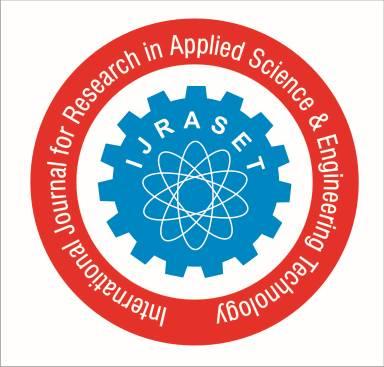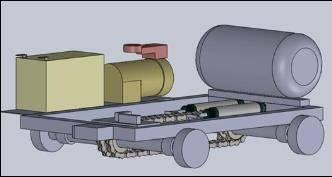
ISSN: 2321-9653; IC Value: 45.98; SJ Impact Factor: 7.538 Volume 11 Issue I Jan 2023- Available at www.ijraset.com


ISSN: 2321-9653; IC Value: 45.98; SJ Impact Factor: 7.538 Volume 11 Issue I Jan 2023- Available at www.ijraset.com
Shivakumar S1 , Mohammed Yahya Dil2, Satyanarayana3
1 Assistant Professor, 2, 3U G Scholar, Department of Mechanical Engineering, Sir M. Visvesvaraya Institute of Technology, Bangalore

Abstract: Air compressed vehicle as it is popularly known has caught the attention of researchers worldwide and is ideal for city driving conditions. Motor development international (MDI) is a French company thatholds international patent for compressed air operated vehicles. Even though it seems to be an eco-friendly solution, one must consider its well to wheel efficiency. While computing the overall efficiency of an air compressed vehicle, the electricity requirement for compressing air has to be considered. Nevertheless, the compressed air vehicle will contribute to reducing air pollution in longer run.
Keywords: Air compressor, battery, pneumaticcylinders, 5/2 solenoid valve, chain andsprocket connection etc.
The environmental challenges posed by passenger cars are significant and require a broad range of evolutionary and revolutionary solutions. Fossil fuels, which are used in vehicles, produce lot of harmful gases like car carbon dioxide, nitrogen oxide, and unburned hydrocarbons. The fossil fuels are also widelyused as a source of energy in various differentfields like power plants, internal & external combustion engines, as heat source in manufacturing industries, etc. But its stock is very limited and due to this tremendous use, fossil fuels are diminishing at faster rate. So, in this world of energy crisis, it is necessary to develop alternative technologies to use renewable energy sources, so that fossil fuels can be conserved. So an alternative way of producing the running the vehicle must bemade so that we can prevent further damageto the earth. The alternative sources of energy available are solar, electric, atmospheric air etc. Air acts like a blanket for the earth. It is the mixture of gasses, which makes it neutral and nonpolluting. It has the property to get compressed to a very high pressure and retain it for a long period of time. It is cheap and canbe found abundantly in the atmosphere. So it can be used as an alternative fuel for the automobiles. Much research is going on in this field and scientists are trying to improve the effectiveness of this technology. It is experimentally found that the efficiency ofthe vehicle ranges from 72-95%. So this can be considered as one of the preferable choicesto run the vehicle. A Compressed-air engine is a pneumatic actuator that creates useful work by compressed air. A compressed-air vehicle is powered by an air engine, using compressed air, which is stored in a tank. Instead of mixing fuel with air and burning it in the engine to drive pistons with hot expanding gases, compressed air vehicles (CAV) use the expansion of compressed air to drive their pistons. Recently several companies have started todevelop Compressed air cars although none have been released to the public, or have beentested bythird parties. In this project, A compressed air vehicle is powered by compressed air which is present in reservoir ,and is remotely controlled by using arduino nano as a microprocessor, Bluetooth module and several other electronic components ,so as to increase its applications in manufacturing industries and various other sectors.
The working principle of ‘Radio controlled air compressed vehicle’ works on the principle of alternate and simultaneous actuation of two double acting cylinders by using a 5/2 direction control valve. The alternate actuation of two double acting cylinders is used to drive a chain and sprocketconnection which is responsible for moving the vehicle forward.
Table 1.2.1 Materials used in project Sno Title Specification
1 Main frame -
ISSN: 2321-9653; IC Value: 45.98; SJ Impact Factor: 7.538 Volume 11 Issue I Jan 2023- Available at www.ijraset.com

2 Air tank 3 litre 3 Compressor 12V DC compressor 4 Valve 5/2 solenoid valve 5 Pneumatic cylinders 20*100 6 Connection pipe 6mm tube 7 Battery 7.5AH 8 Steering Rack and pinion 9 Microcontroller Arduino nano 10 communication Bluetooth module
Venkatesh Boddapati [1] says compressed air storage tanks built with carbon fibre will carry high amount of pressure with minimum volume space with the conventionalengines with zero emission . Airpowered vehicle is the realization of most technology in the field of automotive, eliminating the use of non renewable fuels. We can use this type of technology to develop an air compressed vehicle using acompressor.
Gaurav sugandh [2] in his paper described the working of a four stroke single cylinder Engine which can run on pneumatic power as by compressedair, while developing it some parameters like temperature ,density,emission control, input power were to be mastered for safety.
S. S. Verma. [3] in his paper expressed Compressed air as a source of energy in different uses in general and as a nonpolluting fuel in compressed air vehicles has attracted scientists and engineers for centuries. His paper gave a brief introduction to the latest developments of a compressed-air vehicle along with an introduction to various problems associated with the technology and their solution.
Andrew papson [4] studied characterized the potential performance of CAVs in terms of fuel economy, driving range, carbon footprint, and fuel costs and examines their viability as a transportation option as compared with gasoline and electric vehicles. Subjects of analysis included energy density of compressed air, thermodynamic lossesof expansion, CAV efficiency on a pump-towheels and well-to-wheelsbasis.
Mihai Simon [5] described the research, design and construction of a viable experimental pneumatic driven vehicle. Their main goal was to find ways to drive efficient by using alternative energy, not necessary cheaper, but more environmentalfriendly in increasing polluted metropolis. This was done by developing an experimental pneumaticvehicle running on compressednitrogen gas. Here the technologyused was not much cheaper because ofcompressed nitrogen we decided to overcome this by using regularcompressed air as fuel.
A.H. Ingle [6] This paper deals with the study of compressed air as a fuel for running a 3- wheeler vehicle wherein the compressed air is stored in tank & supplied to the air motor from where rotational motion is obtained .In this project a preliminary investigation is carried out to run avehicle on compressed air. Using this study we were able to develop a 4 wheeler compressed air vehicle integrated with remote control and a steering mechanism for industrial use.
Gopal sahu [7] in his paper expressed that The electricity requirement for compressing air has to be considered while computing overall efficiency. Compressed air vehicle will contributeto reducing air pollution and tend to zero pollution
Increasing consumption of fossil fuels in automobiles leads to evolution of harmful gasses like carbon dioxide, methane, nitrous oxide, carbon monoxide etc. We want to reduce pollution by using of alternate souce of energy in automobiles. So we decide to make a project “Design and construction of air compressedvehicle integrated with radio control”.
ISSN: 2321-9653; IC Value: 45.98; SJ Impact Factor: 7.538 Volume 11 Issue I Jan 2023- Available at www.ijraset.com

In operation, battery powers the air compressor which starts pressurizing the air and transmits it to valves via tubes. AC220V supply is provided to the transformers pair to convert it into 24V AC supply which is converted into 24 V dc supply using rectifier, this dc supply is used to power relay switches which operates the 5/2 solenoid controlled DCV.The simultaneous actuation of 5/2 solenoid controlled DCV transfers the air to each double acting piston cylinders thereby alternatively actuating them .The rods of cylinders are fixed to chain and sprocket connection. As the chains move forward reciprocating motion of pistons is converted to rotating motion ofwheels.
Fig 4.1 Basic design of project usingCatia
1) Compressed technology reduces the cost of vehicle technology by about20% because no need to build a cooling system ,fuel tank , ignition system etc.
2) Fast recharge time.
3) Long storage lifetime of air
4) The air tanks may be refilled more often and in less time than batteries can be recharged.
5) Lighter vehicles cause less damage to the roads, resulting in lower maintainence cost.
1) Limited storage capacities of the compressed air tank.
2) A tank containing 300 MPa of compressed air is riskyand dangerous.

3) Running the vehicle on compressed airwill be requiring the provision for filling the compressed air inthe tank.
The innovation of compressed air vehicles isn't new .It has been around for a really long time, truth be told .Compressed air innovationtakes into consideration motors that are both non-dirtying and prudent. Following decade of examination furthermore, advancement, thecompressed air vehicle will be presented around the world. In contrast to electric or hydrogen controlled vehicles, compacted air vehicles are not costly and don't have a restricted driving reach. Compressed air vehicles are reasonable and have a execution rate that faces current principles. To summarize it, they are non-costly vehicles that don't contaminate and are not difficult to get around in urban communities. The outflow advantages of presenting this zero discharge innovation are self-evident. Simultaneously the well to wheels proficiencyof these vehicles should be gotten to the next level.
1) As there is no ignition utilization of lighter motor parts like carbon fiberfor cylinder will give more effectiveness.
2) Reduction of diameter of piston improves volumetric efficiency.
3) This technology can be improved withincorporation of other power sources like solar, electrical, fossil fuels etc. ,thus making a hybrid system.
ISSN: 2321-9653; IC Value: 45.98; SJ Impact Factor: 7.538 Volume 11 Issue I Jan 2023- Available at www.ijraset.com
[1] Design data book byV.B. Bhandary.
[2] Machine Design byRS Khurmi.
[3] OilHydraulic and Pneumatic bytechmax.
[4] S.M. Yahya, Turbine, Compressor andfans.
[5] Pramod Kumar J. ,“AIR POWERED ENGINE” , International Journal of Mechanical Engineering andTechnology (IJMET) Volume 7, Issue 2, March-April 2016, pp. 66–72, Article ID: IJMET_07_02_010.
[6] Venkatesh Boddapati, S.V.V. Vinod, M.Dora Babu , “Air powered vehicle –an eco-friendly engine” ISSN: 2319- 4413 , January 2015.
[7] Andrew Papson, Felix Creutzig, andLee Schipper , “Compressed Air Vehicles Drive-Cycle Analysis of Vehicle Performance, EnvironmentalImpacts, and Economic Costs” Recordjournal of transportation researchboard 2191(-1):67-74.
[8] Mihai Simon and Maria Iona Simon, “New Research and Design to obtain a Compressed Air Driven Prototype Vehicle” 10th International conference Interdisciplinary in Engineering,INTER- ENG 2016, 6-7 October 2016,Tirgu Mures, Romania.
[9] Verma S. Air Powered Vehicles. The Open Fuels & Energy Science Journal,Vol. 1, 2008, pp. 54–56.
[10] A. H. Ingle, Rashmi Ambatkar, Ronit Badwaik, Diptanshu Pise, Amol Dafare, “ Literature review paper on the compressed air vehicle with air motor” , International Journal of engineering research and technologyIC-QUEST – 2016 (Volume 4 – Issue 30)

[11] Mistry Manish K, Dr.Pravin P.Rathod, Prof. Sorathiya Arvind S, Study and development of compressed air engine single cylinder: a review study, IJAET/Vol.III/ Issue I/January-March,2012.
[12] Prof. B. S. PATEL, Mr R S BAROT, KARAN SHAH, AIR POWERED ENGINE”, National Conference on Recent Trends in Engineering & Technology, 2011.
[13] Dr. Maglub Al Nur, S.K.M.Asikul Islam, Debashish SahaandAashiqueAlam Rezwan,“Modificationof an Si Engine into a Compressed AirEngine to Work with Compressed Air or Gas” , 14th Annual Paper Meet (6IMEC&14APM) 28-29 September 2012.
[14] Kripal Raj Mishra, Gaurav Sugandh, Study About Engine Operated ByCompressed Air: A Pneumatic Power Source, ISOR-JMCE, ISSN No.:- 2278-1684, Volume 2, Issue 6, Nov.- Dec. 14.
[15] Saurabh Pathak, Kontham Shweta, V Shridhar, V.S.V. Prabhakar, Compressed Air Vehicle: A Review, ISSN: 2320- 2092, Volume 2, Issue04, April 2014.
